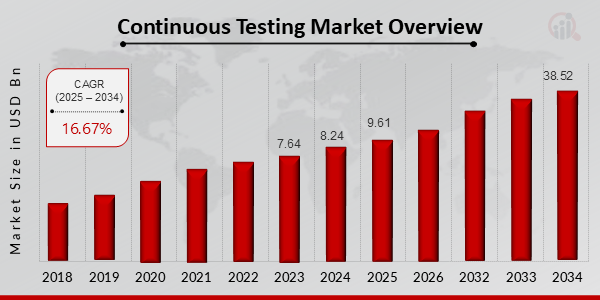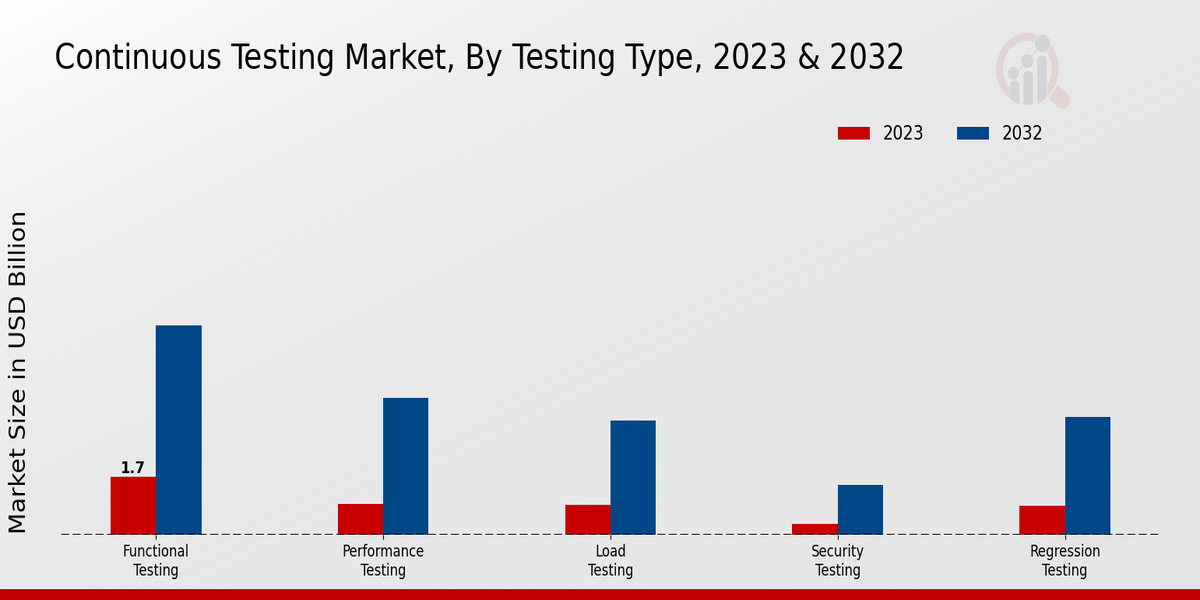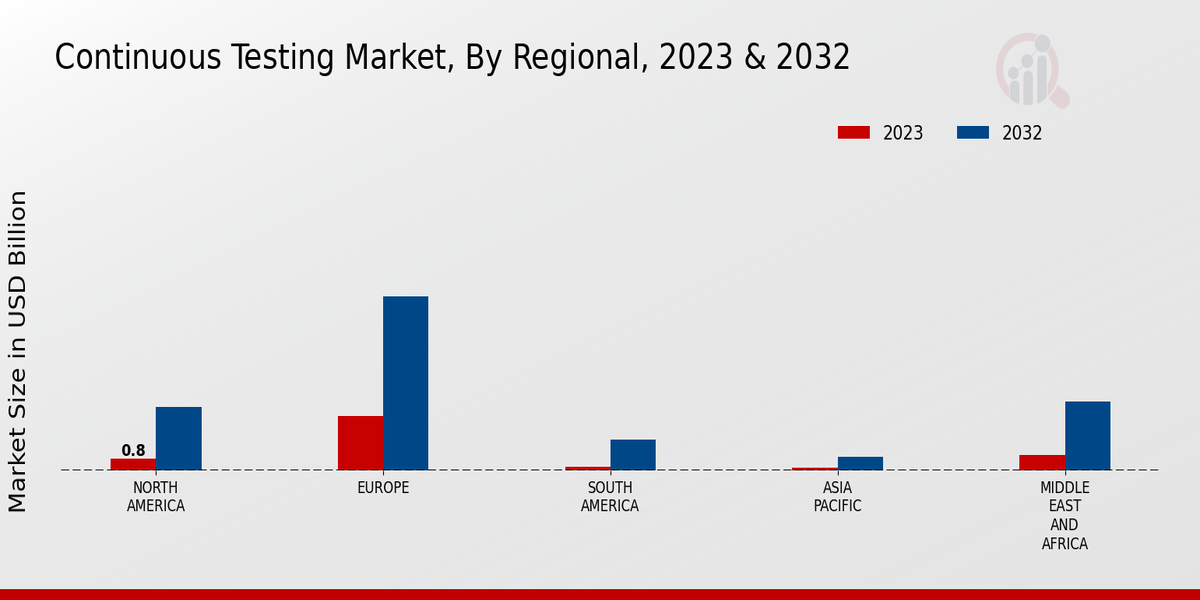Continuous Testing Market Overview
Continuous Testing Market is projected to grow from USD 9.61 Billion in 2025 to USD 38.52 Billion by 2034, exhibiting a compound annual growth rate (CAGR) of 16.67% during the forecast period (2025 - 2034). Additionally, the market size for Continuous Testing Market was valued at USD 8.24 billion in 2024.
Key Continuous Testing Market Trends Highlighted
The Continuous Testing Market is witnessing significant advancements, driven by the increasing demand for agile software development methodologies and DevOps practices. The use of Continuous Testing enables faster and more efficient software delivery by automating testing processes throughout the software development lifecycle.
Key market drivers include the increasing adoption of cloud-based and microservices architectures, which require continuous testing to ensure stability and performance. Moreover, the growing complexity of software applications and the need for faster time-to-market are further fueling the market's growth. Emerging trends in the Continuous Testing market include the rise of artificial intelligence (AI) and machine learning (ML) technologies, which are being used to enhance test automation capabilities and improve test coverage.
Additionally, the adoption of low-code/no-code testing platforms is simplifying test creation and maintenance, making Continuous Testing more accessible to organizations with limited testing resources.
Figure 1: Continuous Testing Market Size, 2025-2034 (USD Billion)

Source: Primary Research, Secondary Research, Market Research Future Database and Analyst Review
Continuous Testing Market Drivers
Rising Demand for Continuous Integration/ Continuous Delivery (CI/CD)
The continuous testing market is mainly driven by the fact that more and more organizations adopt DevOps practices, particularly CI/CD. The latter is used for automating software development so that the code is continuously developed, regularly integrated, tested, and deployed.
In the context of continuous testing, it allows more to be done in less time as all the manual operations typical for the iterative software cycle are automated.
In other words, the DevOps approach implies using CI/CD pipelines to streamline software development and ensure that the products are delivered in a timely fashion so that the operations are both cost and time-efficient. Due to the above reasons, the number of solutions on the market is likely to grow in the near future.
Growing Adoption of Agile Software Development
The growth of the continuous testing market is also prompted by the increasing adoption of the agile software development approach.
Agile development implies the use of iterative development, continuous feedback, and close collaboration between the development and testing teams.
Due to its emphasis on the regular delivery of working software, the agile development approach promotes frequent testing and validation of the software build made. Correspondingly, a greater unit for continuous testing solutions is created.
Using such tools, organizations can automate the software testing processes and incorporate the testing procedures into the development workflow.
As a result, the defects can be identified and addressed promptly which allows for avoiding the issues with the software and the production process.
Increasing Complexity of Software Systems
Another factor that underscores the growing need for continuous testing in the software testing world is the increased complexity of software systems.
Today, many applications involve a wild variety of components, services, and integrations, implying that there are more aspects that developers and testers have to monitor.
In this context, manual testing applications are no longer feasible due to the complexity of software systems that are to be tested.
Given that the continuous testing solutions can be automated to suit modern software systems where not every aspect can be tested manually, continuous testing can be considered to be a market trend.
Continuous Testing Market Segment Insights
Continuous Testing Market Testing Type Insights
The Continuous Testing Market segmentation by Testing Type includes Functional Testing, Performance Testing, Load Testing, Security Testing, Regression Testing, Cross-Browser Testing, and Mobile Testing.
Functional Testing held the largest market share in 2023 and is projected to maintain its dominance throughout the forecast period. This can be attributed to the increasing adoption of agile and DevOps methodologies, which require frequent functional testing to ensure that software applications meet business requirements.
Performance Testing is expected to witness the highest growth rate during the forecast period, owing to the growing need for optimizing application performance and ensuring a seamless user experience.
Load Testing is expected to hold a significant market share, as it is crucial for evaluating the performance of software applications under high load conditions. Security Testing is gaining importance due to the rising concerns over cyber threats and data breaches.
Regression Testing is essential for ensuring that software applications continue to function as expected after changes are made. Cross-browser testing is becoming increasingly important as businesses strive to ensure that their applications are compatible with multiple browsers and devices.
Mobile Testing is expected to grow steadily, driven by the increasing adoption of mobile devices and the growing popularity of mobile applications.
The Continuous Testing Market revenue for Functional Testing is projected to reach USD 4.2 billion by 2024, while Performance Testing is expected to reach USD 2.1 billion by the same year.

Source: Primary Research, Secondary Research, Market Research Future Database and Analyst Review
Continuous Testing Market Deployment Insights
The Continuous Testing Market was widely divided into on-premises and cloud-based on the basis of deployment segment. In terms of revenue, the cloud-based segment in 2023 garnered a considerable share and is anticipated to lead the continuous testing market in the upcoming years.
The increasing adoption of cloud computing services and the requirement of improved agility and flexibility are the reasons for the considerable share of this segment. The cloud-based deployment segment is also projected to have a considerable growth rate in the upcoming period owing to its cost-effectiveness.
On the other hand, the on-premises segment is anticipated to have a steady growth rate in the upcoming years owing to the preference of such solutions by the organizations with high data security and compliance.
Continuous Testing Market Tool Type Insights
The Continuous Testing Market is segmented by Tool Type into commercial and open-source tools. Commercial tools are proprietary software products developed and licensed by commercial software vendors. Open-source tools, on the other hand, are freely available for use, modification, and distribution without the need for licensing fees.
In 2023, the commercial tool segment held a larger market share due to the comprehensive features and support services offered by commercial vendors. Commercial tools typically provide a wide range of features, such as test automation, performance testing, and security testing, along with dedicated customer support and regular updates.
These tools are often developed and maintained by communities of developers and are available for free. Open-source tools provide basic testing capabilities and may require additional customization to meet specific testing needs.
The Continuous Testing Market data for open-source tools is projected to grow at a CAGR of 16.67% from 2024 to 2032, reaching $6.06 billion by 2032. The choice between commercial and open-source tools depends on the specific testing requirements and budget constraints of organizations.
Commercial tools are ideal for organizations that require comprehensive testing capabilities, dedicated support, and regular updates.
Open-source tools are suitable for organizations with limited budgets or those that prefer to customize their testing tools according to their specific needs.
Continuous Testing Market Vertical Insights
The Continuous Testing Market is segmented into various verticals, including Banking, Financial Services and Insurance (BFSI), Healthcare and Life Sciences, Manufacturing, Retail and Consumer Goods, Government and Education, Information Technology, Telecommunications, and Travel and Hospitality.
Among these verticals, BFSI is expected to hold a significant market share in 2023, owing to the increasing adoption of digital technologies and the need for continuous testing to ensure the reliability and security of financial transactions.
The Healthcare and Life Sciences vertical is also expected to witness significant growth due to the growing demand for personalized and data-driven healthcare solutions.
Manufacturing, Retail and Consumer Goods, and Government and Education are other key verticals that are expected to contribute to the growth of the Continuous Testing Market.
Continuous Testing Market Regional Insights
The Continuous Testing Market is segmented by region into North America, Europe, APAC, South America, and MEA. North America held the largest market share in 2023, accounting for 35.6% of the Continuous Testing Market revenue.
The region's dominance can be attributed to the presence of a large number of technology companies and the early adoption of continuous testing tools and practices. Europe is expected to be the second-largest market for continuous testing, with a market share of 28.2% in 2023.
The region has a strong manufacturing and automotive industry, which is driving the demand for continuous testing solutions.
APAC is expected to be the fastest-growing region for continuous testing, with a CAGR of 18.7% during the forecast period. The region's growth is being driven by the increasing adoption of agile and DevOps methodologies, as well as the growing number of software development companies in the region.
South America and MEA are expected to have a relatively smaller market share, but both regions are expected to witness significant growth in the coming years.

Source: Primary Research, Secondary Research, Market Research Future Database and Analyst Review
Continuous Testing Market Key Players and Competitive Insights
Major players in the Continuous Testing Market are continuously engaged in developing innovative solutions to meet the evolving demands of customers. Leading Continuous Testing Market players are focusing on strategic collaborations and partnerships to expand their global reach and enhance their product portfolios.
The Continuous Testing Market is characterized by intense competition, with vendors vying for market share through product differentiation, aggressive pricing, and strategic marketing initiatives. Continuous Testing Market development is driven by technological advancements, such as the rise of cloud computing, DevOps, and artificial intelligence.
The Continuous Testing Market Competitive Landscape is expected to remain highly competitive in the coming years, with key players focusing on delivering innovative solutions, expanding their geographic presence, and forming strategic alliances.
A leading player in the Continuous Testing Market is Micro Focus, which offers a comprehensive suite of continuous testing solutions, including ALM Octane, LoadRunner, and UFT One. Micro Focus is known for its strong focus on customer success and its commitment to delivering high-quality products.
The company has a wide global presence and serves a diverse customer base across various industries. Micro Focus is consistently recognized for its leadership in the continuous testing space and is a key player in shaping the future of the market.
A competitor company in the Continuous Testing Market is Tricentis, which provides a range of continuous testing solutions, including Tosca, qTest, and Flood.
Tricentis is known for its innovative approach to continuous testing and its focus on delivering solutions that are easy to use and highly effective.
The company has a strong global presence and has established itself as a trusted partner for many leading organizations.
Tricentis is continuously investing in research and development to enhance its product portfolio and stay at the forefront of the continuous testing market.
Key Companies in the Continuous Testing Market Include
Continuous Testing Market Developments
The Continuous Testing Market is poised to experience substantial growth between 2023 and 2032, driven by the increasing adoption of agile and DevOps methodologies, the need for faster software delivery, and the growing emphasis on software quality.
Recent developments in the Continuous Testing Market include the launch of new tools and platforms, such as Tricentis Flood, which automates functional and performance testing.
Additionally, there is a growing trend towards cloud-based continuous testing solutions, as they offer scalability, flexibility, and cost-effectiveness.
Some of the key players in the Continuous Testing Market include Tricentis, Applitools, Micro Focus, and SmartBear Software. These companies are investing in research and development to enhance their offerings and expand their market share.
Continuous Testing Market Segmentation Insights
-
Continuous Testing Market Testing Type Outlook
-
Continuous Testing Market Deployment Outlook
-
Continuous Testing Market Tool Type Outlook
-
Continuous Testing Market Vertical Outlook
- Banking, Financial Services and Insurance (BFSI)
- Healthcare and Life Sciences
- Retail and Consumer Goods
-
Continuous Testing Market Regional Outlook
| Report Attribute/Metric |
Details |
|
Market Size 2024
|
8.24 (USD Billion)
|
|
Market Size 2025
|
9.61 (USD Billion)
|
|
Market Size 2034
|
38.52 (USD Billion)
|
|
Compound Annual Growth Rate (CAGR)
|
16.67% (2025 - 2034)
|
|
Report Coverage
|
Revenue Forecast, Competitive Landscape, Growth Factors, and Trends
|
|
Base Year
|
2024
|
|
Market Forecast Period
|
2025 - 2034
|
|
Historical Data
|
2019 - 2023
|
|
Market Forecast Units
|
USD Billion
|
| Key Companies Profiled |
Appvance, SmartBear, Abstracta, Tricentis, Dynatrace, Worksoft, Perfecto, Rainforest QA, Functionize, mabl, CAST Software, SeleniumHQ, Aiven, Parasoft |
| Segments Covered |
Testing Type, Deployment, Tool Type, Vertical, Regional |
| Key Market Opportunities |
Cloud-based testing AIML integration DevOps adoption Agile development Expansion into emerging markets |
| Key Market Dynamics |
Growing adoption of DevOps Increasing demand for faster software delivery Rising need for improved software quality Adoption of cloud-based continuous testing solutions Growing adoption of artificial intelligence AI |
| Countries Covered |
North America, Europe, APAC, South America, MEA |
Frequently Asked Questions (FAQ):
The Continuous Testing Market is expected to reach USD 9.61 billion in 2025 and is projected to grow at a CAGR of 16.67% from 2025 to 2034, reaching USD 38.52 billion by 2034.
North America is expected to hold the largest market share in the Continuous Testing Market, followed by Europe and Asia-Pacific. The growth in these regions is attributed to the increasing adoption of DevOps practices and the rising demand for automated testing solutions.
Continuous Testing is used in various applications, including functional testing, performance testing, security testing, and compliance testing. It helps organizations to identify and fix bugs early in the development process, reducing the time and cost of testing.
Some of the key competitors in the Continuous Testing Market include Applitools, BlazeMeter, CA Technologies, CloudBees, Micro Focus, Perfecto, Rainforest QA, Sauce Labs, and Tricentis.
Key trends in the Continuous Testing Market include the increasing adoption of cloud-based testing solutions, the growing popularity of open-source testing tools, and the emergence of artificial intelligence (AI) and machine learning (ML) in testing.
Challenges in the Continuous Testing Market include the lack of skilled professionals, the need for integration with existing testing tools, and the complexity of testing in agile and DevOps environments.
The future outlook of the Continuous Testing Market is positive. The market is expected to continue to grow as organizations increasingly adopt DevOps practices and automated testing solutions to improve the efficiency and quality of their software development processes.
Key factors driving the growth of the Continuous Testing Market include the increasing adoption of DevOps practices, the rising demand for automated testing solutions, and the growing awareness of the benefits of continuous testing.
Key opportunities in the Continuous Testing Market include the expansion of the cloud-based testing market, the development of new open-source testing tools, and the emergence of AI and ML in testing.
Key challenges in the Continuous Testing Market include the lack of skilled professionals, the need for integration with existing testing tools, and the complexity of testing in agile and DevOps environments.

















